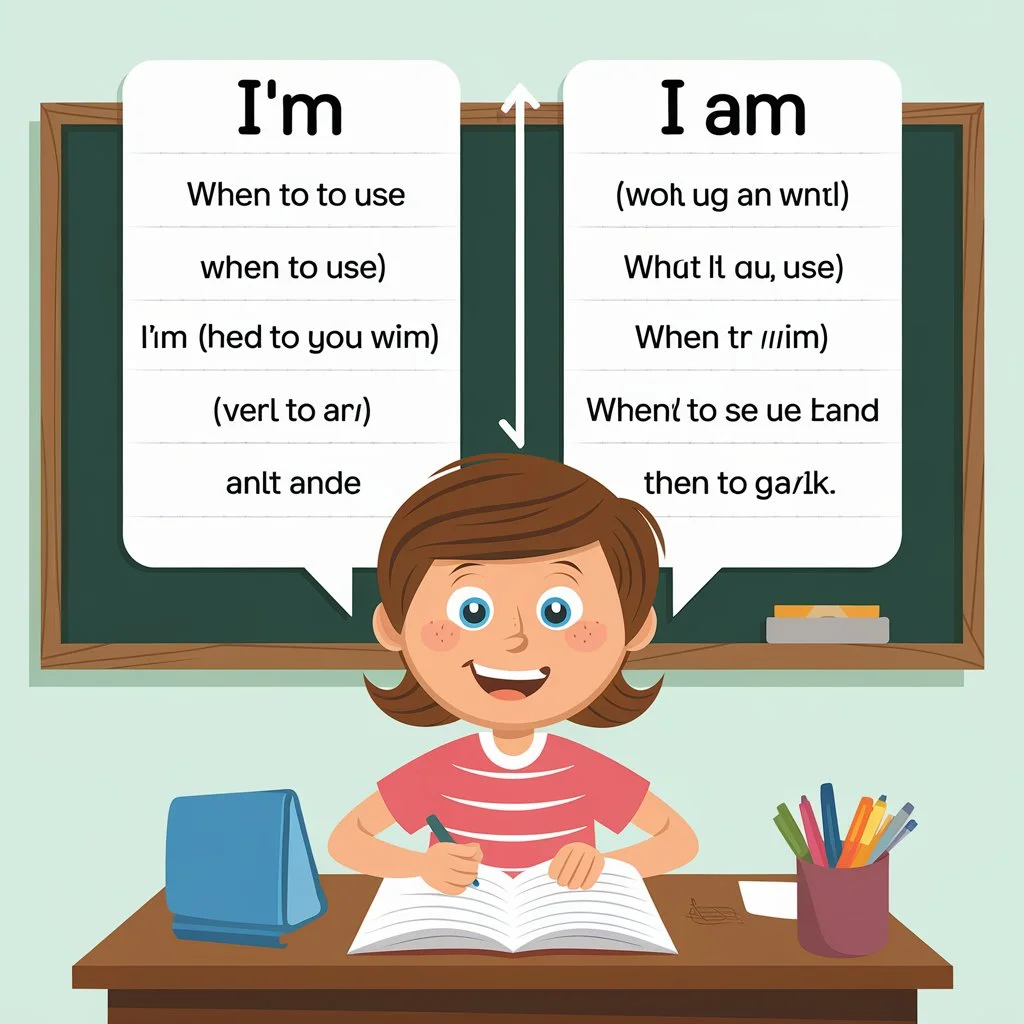Using “I’m” instead of “I am” is one such example. But when is it appropriate to use each form? Let’s break it down.Sometimes, we use contractions in writing to make sentences shorter and easier to understand.
Which Is Correct: I’m or I Am?
“I’m” should be used in informal writing and when you want to contract the phrase “I am.” It is mostly used before a noun phrase, like “I’m a man.” On the other hand, “I am” is used in formal writing or when you want to emphasize a noun. For example: “A man, I am,” or “I am a man.”
Example Usage of I’m
Understanding the rules is one thing, but seeing examples helps make it clearer. Let’s look at some examples of how “I’m” is commonly used.
“I’m” is frequently used in speech because it saves time and is easier to say, requiring only one syllable instead of two. It’s also common in informal writing where contracting “I am” is more natural before a noun phrase.
- I’m on my way to see you.
- I’m not sure you know what you’re doing.
- I’m okay.
- I’m here to help.
- I’m happy for you.
- I’m ready when you are.
- I’m on my way to meet you.
- I’m really excited about the trip tomorrow.
- I’m not sure how to solve this problem.
- I’m happy to help you with your assignment.
- I’m feeling a bit tired today.
- I’m sorry, but I can’t make it to the meeting.
- I’m looking forward to our vacation next month.
- I’m ready when you are.
- I’m grateful for your support.
- I’m planning to work on the project later.
- I’m interested in learning a new language.
- I’m here if you need to talk.
- I’m excited to start this new job.
- I’m confident that we can achieve our goals.
- I’m not sure if that’s the right decision.
These are common sentences in everyday English. Since people often speak in the first-person singular, the pronoun “I” is used a lot. As a result, the contraction “I’m” is also incredibly common.
In many cases, writing the verb “to be” (or “am” in this case) follows the pronoun “I” to show your intent. It tells the listener or reader that you’re either ready for action or stating something about yourself. This makes “I’m” a frequent and necessary part of English.
However, keep in mind that “I’m” is mainly used in spoken language or informal writing.
Example Usage of I Am
Now, let’s look at examples of when “I am” might be more appropriate. This phrase is typically used for two main reasons:
In formal writing, such as letters.
To emphasize a noun in a sentence, either by placing “I am” before the noun and stressing the “am,” or by placing it afterward for emphasis.
- I am here; you just haven’t noticed me!
- I am so happy to hear back from you.
- I am writing regarding our recent conversation.
- I am updating you about your wellness plan.
- I am uncomfortable with you knowing any more details.
- I am unsure you have your facts correct.
- I am fully prepared for the presentation.
- I am confident that we will succeed.
- I am excited to see you tomorrow.
- I am grateful for the opportunity to work here.
- I am sorry for the misunderstanding.
- I am happy to help with the project.
- I am aware of the situation.
- I am writing to express my gratitude.
- I am focused on achieving my goals.
- I am proud of what we have accomplished.
- I am unsure if that is the best decision.
- I am eager to learn more about this topic.
- I am concerned about the outcome.
- I am committed to this project.
- I am confident in my abilities.
In these examples, “I am” is placed at the start of the sentence, but it’s also possible to place it later, like “A man, I am.” Although this is now outdated and rarely used, it’s a way to mix up the sentence structure for emphasis.
You’ll notice that in most cases, “I am” is used in more formal contexts. In formal writing, contractions like “I’m” are generally avoided. This is because contractions can be seen as too casual or rushed, and these are traits that you want to avoid in formal writing.
Can I Use I’m in a Formal Letter?
In most cases, you should avoid using “I’m” in a formal letter. Instead, opt for “I am.”
Even if you’re writing to someone you know well, and they might not mind the contraction, it’s best to play it safe. “I’m” is a casual contraction that’s better suited for conversational or informal writing. When writing formal documents, “I’m” should be left out for the sake of maintaining proper grammar.
For example, if you’re writing a formal letter, use phrases like:
- I am writing this letter to inform you…
- I am writing regarding your recent letter…
- I am writing to inform you of my proposal…
Each of these phrases helps to start a letter properly. As you can see, using “I’m” in place of “I am” could be seen as unprofessional. If you start your letter informally, some people may stop paying attention to your message, making “I’m” a risky choice in formal writing.
Should I Capitalize “I’m” in the Middle of a Sentence?
One common question is whether to capitalize “I’m” in the middle of a sentence. People get confused because other words are usually not capitalized unless they are proper nouns. So, when should you capitalize “I’m”?
The answer is simple: Always capitalize “I’m”. The pronoun “I” is always capitalized, regardless of its position in a sentence. Since “I’m” is a contraction that includes the pronoun “I,” it should always be written with a capital I.
Correct: If you are here, I’m happy to help out now!
Incorrect: I need some help, i’m lost!
Correct: Hello there, I’m George!
Incorrect: Howdy, i’m Smith!
Is I’m Considered a Word?
Yes, “I’m” is considered a word. It is a contraction, which is a shortened form of a word or phrase. While contractions might seem informal, they are still recognized parts of the English language.
So, if someone asks whether “I’m” is a real word, the answer is yes. Just like “it’s” is a contraction of “it is,” “I’m” is a contraction of “I am,” and both are accepted words in English.
Im vs. I’m
One final point to remember is the importance of the apostrophe when writing “I’m.” The apostrophe shows that two words have been combined into a contraction. Without it, “Im” would be pronounced like “him” without the “H,” and it wouldn’t make sense.
Apostrophes are key when forming contractions. Just like “it’s” or “there’s,” always make sure that “I’m” has its apostrophe in place.
FAQs
When should I use “I’m” instead of “I am”?
Use “I’m” when you are writing or speaking in a more casual or informal setting. This contraction helps make your sentences shorter and sounds more conversational. It’s often used in everyday conversations or informal texts, such as emails to friends or casual social media posts. However, avoid using it in formal writing, such as business letters or academic papers. Instead, use “I am” in those cases to maintain a more professional tone.
Is it wrong to use “I’m” in formal writing?
Yes, it is generally considered inappropriate to use “I’m” in formal writing. Formal writing should be clear, precise, and professional, and contractions like “I’m” can make your writing appear too casual. In formal documents such as reports, letters, or academic essays, it’s better to use “I am” to give your text the appropriate level of seriousness and professionalism. Save contractions for informal communication.
Can I use “I am” to sound more emphatic?
Absolutely! “I am” is often used to add emphasis to your statement, especially when you want to make a point stronger. For example, saying “I am really excited” stresses your excitement more than saying “I’m really excited.” You can use “I am” to emphasize your feelings, intentions, or identity in situations where it’s important to stress those points.
Is it ever okay to use “I’m” in professional emails?
In some cases, it might be acceptable to use “I’m” in a professional email, but it depends on your relationship with the recipient. If you’re emailing a colleague or someone you have a friendly rapport with, using contractions like “I’m” can make the tone feel more natural. However, when in doubt, or when writing to someone in a position of authority, it’s better to use “I am” to maintain a respectful and professional tone.
What’s the difference between “Im” and “I’m”?
The difference lies in the use of the apostrophe. “Im” without an apostrophe is incorrect and not a real word in English. The correct form is “I’m,” which uses the apostrophe to show that two words (I + am) have been contracted. Without the apostrophe, it would be difficult to understand the intended meaning, and the word would be grammatically incorrect.
Why should I always capitalize “I’m” in the middle of a sentence?
The pronoun “I” is always capitalized in English, no matter where it appears in a sentence. This means that the contraction “I’m” should also always have a capital I. It doesn’t matter if it appears at the start, middle, or end of a sentence—capitalizing the “I” in “I’m” is an important rule to follow in English grammar. For example: “If you need help, I’m here for you!”
Conclusion
Choosing between “I’m” and “I am” might seem minor, but it can have a big impact on the tone of your writing or speech. By understanding when to use each form, you’ll be able to communicate more clearly and effectively. Whether you’re trying to sound casual or professional, the right choice will help you get your message across in the best way. Remember, in formal settings, it’s always safer to use “I am” for clarity and professionalism. As the famous writer Mark Twain once said, “The difference between the almost right word and the right word is really a large matter—’tis the difference between the lightning bug and the lightning.“

I’m Clara Whitmore, the girl running the show at “Grammer Grove.” I’ve been playing with expressions and formats to make grammer a whole lot of fun. Over at Grammer grove, we’re here to make your English grammer incredible. Let’s add some professionalism and gratitude to yourwritting together!












